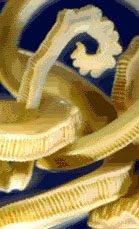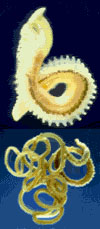














"Flatworm"
Totally intersting facts about flatworms:
-
Flatworms are bilaterally symmetrical
-
They lack respiratory and circulatory systems
-
Exhibits the adaption of cephalization
-
Aproximately 2,000 species of flatworms exist and all are
multicellular living in marine, freshwater and damp terrestrial habitats.
-
There are both parasitic and free living species.
Platyhelminthes can be divided into four classes:
Click on the above classes or the picture below for more information
on each:




Turbellaria
Trematoda
Monogenea
Cestoda
Copyright:
Lori
Gross
Copyright: The
Tree of Life Copyright: The
Tree Of Life
Copyright:
The
Aberdeen Zoology Museum
Platyhelminthes, the flatworms, are the simplest
animals that are bilaterally symmetrical and triploblastic. Triploblastic
means composed of three fundamental cell layers. Flatworms have no body
cavity or anus; only larger flatworms contain a gut. A pharyngeal opening
both takes in food and excretes waste. The gut is often very highly branched
in order to transport food to all parts of the body. The lack of a cavity
also constrains flatworms to be flat. They must respire by diffusion from
the cells to the outside environment. Since no cell can be more than three
cells away from an oxygen and nutrient source, a flattened shape is necessary.
Flatworms are divided into four groups. The Turbellaria
include the planarian and are mainly free-living. Their living environments
include oceans, fresh water, and moist terrestrial habitats. A few are
parasitic living inside its host. The parasitic Trematoda, or flukes, have
complex life cycles specialized for parasitism in animal tissues. The Cestoda,
or tapeworms, are intestinal parasites in vertebrates. They also seem to
show anatomical and life history modifications for parasitism. Monogeneans
are very close to trematoda in habit and anatomy. They are differentiated
by having a structure called an opisthaptor
Platyhelminths have practically no fossil record.
A few trace fossils have been reported that were probably made by platyhelminths.
Fossil trematode eggs have been found in Egyptian mummies and in the dried
dung of Pleistocene ground sloth. Trematode larvae that parasitize molluscs
may leave pits or thin spots on the inside of the shell, and these pits
may be recognized on fossil shells. If the mollusc is irritated by the
presence of trematode larvae, it may be able to surround them with layers
of shelly material. This occurance seems to make parasites become natural
pearls.
It now seems likely that the first two of these
groups are paraphyletic; that is, they contain some but not all descendants
of a common ancestor. Recent molecular studies suggest that the Platyhelminthes
as a whole may even be polyphyletic, having arisen as two independent groups
from different ancestral groups. If this latter view is correct, then most
of the flatworms may belong to the Lophotrochozoa, a large group within
the animal kingdom that includes molluscs and earthworms, while the rest
belong near the base of animal diversity.



